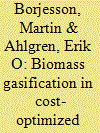|
|
|
Sort Order |
|
|
|
Items / Page
|
|
|
|
|
|
|
| Srl | Item |
| 1 |
ID:
093481


|
|
|
|
|
| Publication |
2010.
|
| Summary/Abstract |
Biomass integrated gasification combined cycle (BIGCC) plants could, in combined heat and power (CHP) generation, increase the power-to-heat ratio compared to conventional biomass steam turbine plants. Furthermore, biomass gasification could also be used for the efficient production of biofuels for transport. In this study, different applications of biomass gasification in connection to district heating (DH) are analysed and contrasted to conventional technology options. An application of the cost-optimizing energy system model MARKAL with a detailed description of the DH sector in a southwestern region of Sweden was developed within the study and used in the analysis. Policy measures for CO2 reduction and for promotion of "green" electricity are assumed, and required subsidy levels for large-scale production of transport biofuels are calculated. The model also operates with different supplies of biomass: a local supply at a lower cost and an international supply of refined biomass at a slightly higher cost. The study shows that investments in BIGCC CHP are often cost-efficient in cases with low ambitions regarding transport biofuels. However, due to limitations in heat demand and in local, lower cost, supply of biomass, investment in biofuel production means less investment in BIGCC CHP and, thereby, a smaller electricity production.
|
|
|
|
|
|
|
|
|
|
|
|
|
|
|
|
| 2 |
ID:
116912


|
|
|
|
|
| Publication |
2012.
|
| Summary/Abstract |
This work presents the development situation of biomass gasification power generation technology in China and analyzes the difficulty and challenge in the development process. For China, a large agricultural country with abundant biomass resources, the utilization of biomass gasification power generation technology is of special importance, because it can contribute to the electricity structure diversification under the present coal-dominant electricity structure, ameliorate the environmental impact, provide energy to electricity-scarce regions and solve the problems facing agriculture. Up to now, China has developed biomass gasification power generation plants of different types and scales, including simple gas engine-based power generation systems with capacity from several kW to 3 MW and integrated gasification combined cycle systems with capacity of more than 5 MW. In recent years, due to the rising cost of biomass material, transportation, manpower, etc., the final cost of biomass power generation has increased greatly, resulting in a serious challenge in the Chinese electricity market even under present preferential policy for biomass power price. However, biomass gasification power generation technology is generally in accord with the characteristics of biomass resources in China, has relatively good adaptability and viability, and so has good prospect in China in the future.
|
|
|
|
|
|
|
|
|
|
|
|
|
|
|
|
| 3 |
ID:
117307


|
|
|
|
|
| Publication |
2013.
|
| Summary/Abstract |
Biomass Integrated Gasification Combined Cycles (BioIGCC) are a promising technology, alternative to fossil fuels for power generation. Significant reduction of CO2 emissions could be achieved, although important changes in the gas turbines and gasifiers design and further technological development would be necessary. The aim of this work is to study quantitatively the benefits of using BioIGCC plants instead of fossil fuel technologies, in terms of power supply and CO2 emission avoidance, including the study of pre-combustion CO2 capture. Different biomass substrates are analysed and compared and the required land use in each case and for different scenarios is also studied and quantified. The power generation and greenhouse gas emission avoidance potential of BioIGCC technology in Europe is also studied and the viability of this technology in different circumstances is discussed. In several cases BioIGCC plants are found to be viable from the point of view of availability of biomass resources and the cost of the produced kWh. In the whole EU-27 the potential hovers around 30 GW and a reduction of nearly 4% of the total EU emissions in 2009 in a conservative scenario, and up to 100 GW and 15% of emission reduction in a more optimistic one.
|
|
|
|
|
|
|
|
|
|
|
|
|
|
|
|
|
|
|
|
|